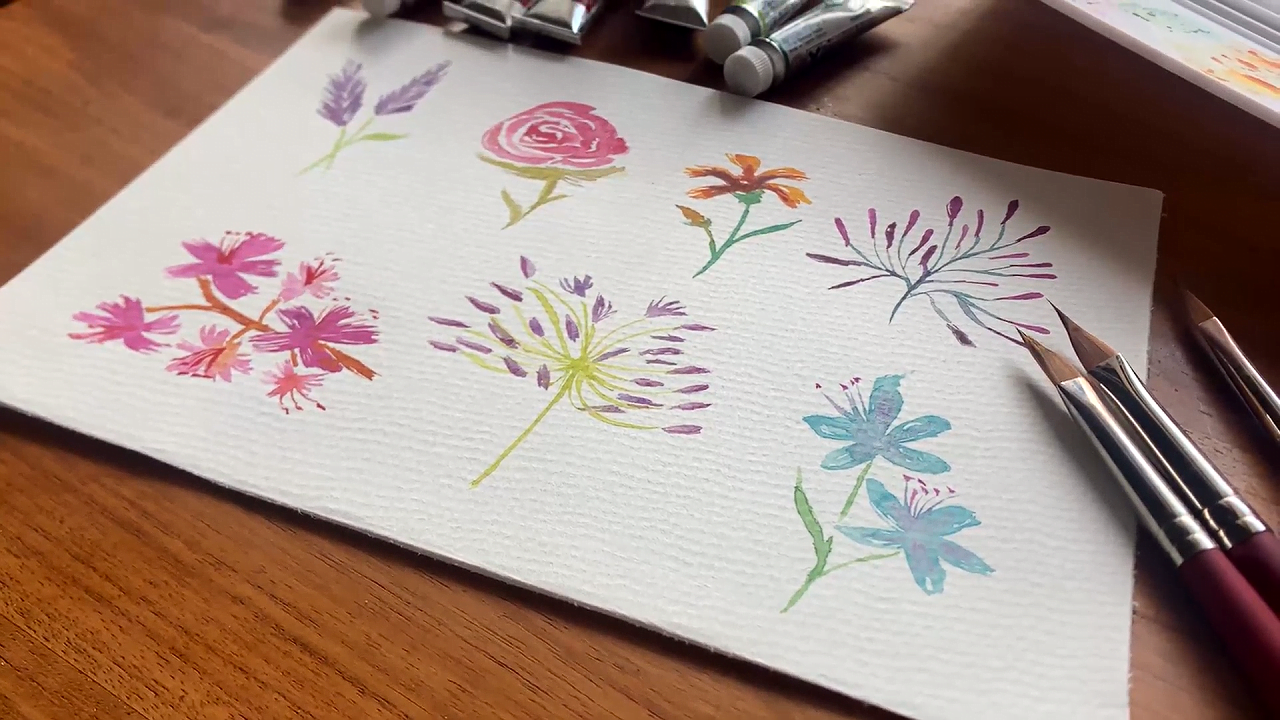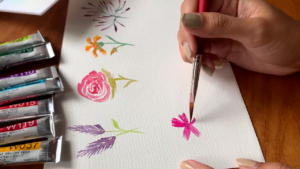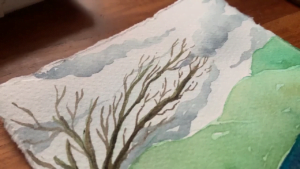Watercolor Papers: Hot Pressed vs Cold Pressed vs Rough
The combination of wood pulp and cotton is employed in crafting watercolor papers, resulting in a more absorbent and durable paper type. Moreover, the texture and weight of the paper is critical and affects the outcome of the painting. Watercolor paper has three main types: hot-pressed, cold-pressed, and rough. Hot-pressed paper is the smoothest with […]

The combination of wood pulp and cotton is employed in crafting watercolor papers, resulting in a more absorbent and durable paper type. Moreover, the texture and weight of the paper is critical and affects the outcome of the painting.
Watercolor paper has three main types: hot-pressed, cold-pressed, and rough. Hot-pressed paper is the smoothest with the slightest texture, making it ideal for intricate paintings that require precision.
Cold-pressed paper is the most popular and balances detail and texture, making it suitable for most painting styles. Rough paper has the highest texture, creating an expressive and impressionistic painting style. So, choosing the right paper for your painting is crucial for achieving the intended outcome.
Hot Pressed Watercolor Paper

Hot-pressed paper, commonly labeled as HP, is a type of watercolor paper that is made using a technique called hot pressing. This type of papermaking involves passing the paper sheets through heated rollers at high pressure, resulting in a smooth, flat surface texture. Such a texture is not only suitable for the watercolor strokes, but also suitable for pen or pencil strokes.
One of the critical characteristics of hot press paper is its ability to hold fine details. The smooth surface allows for precise brushwork, making it a popular choice among watercolor artists who want to showcase their technical skills. It is also well-suited for styles that highlight the paint’s watery irregularities, making it an excellent option for glazing and layering techniques.
Pros And Cons Of Hot Press Watercolor Paper For Artists
Hot-pressed paper has a lower absorbance than other types of watercolor paper, giving watercolor artists more time to work with the paint before it dries. This also means that the colors appear brighter on the paper, as light is reflected directly off the flat white surface.
However, hot-pressed paper has some disadvantages that an artist should consider. The smooth texture can make it challenging to achieve a varied, textured look in a painting. Unlike cold-press watercolor paper, which has little bumps and divots on the surface, hot press paper is smooth and flat, thereby lacking texture.
One of the biggest issues with hot press paper is that it is not very forgiving when it comes to mistakes or corrections. This is because it can be difficult to lift the paint from the surface once it has dried. Hence, it can be a significant problem for artists who like to experiment and make changes to their work as they go.
Considerations For Using Hot Press Watercolor Paper
Another factor to consider is the quality of the hot press paper. Not all hot pressed papers are created equal, and lower quality options may not be pH neutral. This means that over time, the paper can turn yellow or deteriorate, which is a significant concern for artists who want their work to last. It’s crucial to select high-quality, acid-free paper to ensure that your artwork remains in good condition over time.
Despite certain drawbacks, hot press paper can be an excellent choice for certain watercolor paintings. It is ideal for artists who want to create precise, detailed work or prefer a smooth surface finish. Moreover, such a paper is suitable for artists who want to combine watercolor with ink or other drawing media.
The paper’s smoothness allows for excellent ink flow and is perfect for artists who prefer to incorporate detailed line work into their watercolor paintings. Ink applied to hot press paper will remain crisp and sharp, enhancing the painting’s overall visual impact.
Moreover, hot press paper can also be used with other drawing media, such as colored pencils or pastels. The paper’s smooth surface allows for better control and precision, making it an excellent choice for artists who want to create intricate and detailed artworks.
One potential drawback of hot press paper is that it can be less forgiving than other watercolor paper types, such as cold press or rough paper. Since the paper’s surface is smooth, it can be more challenging to control the flow of watercolor paint. However, with practice and experience, artists can master the use of hot press paper and create stunning watercolor paintings.
Cold Pressed Watercolor Paper
Cold pressed watercolor paper, or CP paper, is a type of paper that artists commonly use due to its versatile nature. “Cold Press” refers to the process used to manufacture the paper. To create cold-press paper, sheets of cellulose pulp are pressed through machine-like felt-covered metal rollers at a cold temperature, resulting in a bumpy texture.
The texture of cold pressed watercolor paper provides a more absorbent surface than hot press watercolor paper, which means that the pigments in the paint fix to the paper more quickly. Depending on the artist’s style and preference, this can be both an advantage and a disadvantage. The texture also adds to the aesthetic appeal of the final painting, as the paint pigments settle and dry in the grooves of the paper, revealing the texture of the paper.
Advantages Of Using Cold Pressed Watercolor Paper For Watercolor Paintings
One advantage of using cold press paper is that it is versatile and can be used for various painting techniques. It is also stable when wet, meaning that it does not warp or buckle under the weight of water, making it suitable for wet-on-wet techniques. Additionally, cold press paper tolerates some lifting off and corrections, allowing the artist to change the painting as they work.
Cold press paper is an ideal choice for artists who require a textured surface for their watercolor paintings. This type of paper can create a textured appearance for landscapes with lots of foliage, helping to capture the illusion of leaves and branches. Additionally, the unique texture of cold press paper is used to capture fine details in a painting.
Tip
This is particularly important for artists, as the smooth texture of hot press paper may not be enough to convey the subject matter. But cold press paper can help capture the intricacies of the subject matter and provide an added dimension to the artwork.
Artists who prefer a smoother surface may prefer hot press paper, but for those who want to create textured pieces, cold press paper is often the best choice.
Disadvantages Of Cold Press Paper For Painting
Despite its many advantages, there are also some disadvantages to using cold press paper. One of the main disadvantages is that the bumpy surface of the paper can make it more difficult to create smooth strokes. Additionally, the colors on cold press paper can appear slightly paler and less affluent than on hot press paper because of the way light reflects off the textured surface of the paper.
Another potential disadvantage of cold press paper is its weight. Water color paper is available in a range of weights, measured in grams per square meter (gsm). While heavier paper can handle more water and provide a sturdier surface, it can be more expensive and may only be necessary for some painting styles. Similarly, some artists may prefer paper which is acid-free, which is less likely to turn yellow over time, while others may prefer paper made from cotton fiber, which is more durable.
Ultimately, the choice between cold and hot press paper comes down to personal preference and the specific requirements of the painting. While cold press paper is more versatile and provides a textured surface suitable for many painting styles, there may be better choices available for artists.

Rough Watercolor Paper
The rough paper is a variant of the aqueous color parchment with a profoundly convoluted exterior, thereby making it a prime option for crafting paintings with intriguing and expressive outcomes. This parchment is composed by pressing fibrous wooden pulp materials to produce a lumpy surface, culminating in a textured parchment that takes in water and pigment.
The Unique Benefits Of Using Rough Watercolor Paper For Painting
The greatest attribute of rugged parchment is its highly rough surface. This surface offers a natural opposition to the movement of water and pigment to deliver fascinating outcomes in a painting. The lumps and ridges on the rough surface of the parchment help produce innate patterns and fluctuations in hue, which can create profound and intricate patterns in a painting.
Rough water color paper is an excellent choice for artists who seek to create expressive and bold paintings. Its superior absorbent qualities allow it to hold large quantities of water and pigment, giving artists greater creative freedom to produce captivating effects.
Unlike other types of watercolor paper, the rougher texture of this papers helps it stand out from other papers. This is ideal for artists who want to create paintings with a distinctive flair and character.
Disadvantage Of Using Rough Paper
While the rough paper has many advantages, there are also some disadvantages to using this type of paper. One of the primary disadvantages is that the bumpy surface of the paper can make it difficult to create precise details in a painting. The texture of the paper can interfere with the flow of the brush and make it challenging to create fine lines and delicate details.
Another disadvantage of rough paper is that it can be of lower quality than other types of watercolor paper. Rough paper is often made from wood pulp, which can make it less durable and more prone to yellowing over time. However, many manufacturers now produce rough acid-free paper, which helps to reduce this problem.
In addition, rough paper can be more expensive than other types of watercolor paper, as it is often sold in square meters rather than in individual sheets. Rough paper also has two deckle edges, so it may not be suitable for artists who prefer to work with squared-off edges.
It is a unique and versatile type of watercolor paper that can create mind boggling and expressive effects in a painting. Moreover, the heavily textured surface and ability to hold large amounts of water and pigment make it an excellent choice for artists who want to create loose, expressive art with natural patterns and organic textures.
But there may be better choices than rough paper for artists who require precise details or prefer squared-off edges. Ultimately, choosing watercolor paper is a personal preference, and an artist should experiment with different types of paper to find the one that works best for their style and technique.
How To Choose The Right Paper
When selecting watercolor paper for a painting, it is important to consider factors such as the subject matter, desired level of detail, and preferred painting technique. Each type of paper has its own unique characteristics that can affect the stroke, glaze, and mold of the artwork.
For instance, rough watercolor paper has the most textured surface of the three, which makes it ideal for adding a sense of depth and texture in an illustration. Rough paper may work well for landscapes, while hot-pressed paper may be better suited for detailed portraits or botanical paintings that require fine lines and precise brush strokes. The weight of the paper also matters, as heavier papers tend to be more durable and can handle more layers of paint.
Cold-pressed watercolor paper has a slightly textured surface, which gives it a more natural feel and allows for a variety of stroke techniques. This paper is versatile and can be used for a range of illustrations, from landscapes to abstract art. Cold-pressed paper can even absorb more water than hot-pressed paper, which can deliver interesting textures and glazes.
It is essential to experiment with different papers to find the one that works best for an individual’s style and preferences. Trying out a variety of papers will allow an artist to see how different papers absorb water and pigment, how they handle brushstrokes and washes, and how they affect the overall appearance of their work.
Such experimentations help an artist make more informed decisions about which paper to use for a particular painting and can lead to discovering new and exciting techniques.
Differentiation Between All : Hot, Cold And Rough Paper
Watercolor paper is an essential tool for watercolor artists, providing a surface that can handle the unique characteristics of watercolor paint. While there are several types of watercolor paper available, including rough, cold-pressed, and hot-pressed, each type offers its own distinct texture and finish.
Rough watercolor paper has a heavily textured surface that features noticeable bumps and irregularities. This texture creates dynamic and expressive paintings with a lot of movement and energy. The rough surface is also excellent for creating texture in the painting, mimicking the appearance of natural surfaces like rocks or tree bark.
Cold-pressed watercolor paper is the most commonly used type of watercolor paper. Its medium texture and slightly rough surface provide a balance between the absorbency of the paper and the smoothness of the finish. This versatility makes it suitable for various painting techniques, from detailed work to washes and gradients.
Hot-pressed watercolor paper has a smooth surface, making it ideal for creating fine details and sharp lines. This type of paper is often used for precise paintings, such as botanical illustrations or portraits. The low absorbency of hot-pressed paper allows the paint to sit on the surface, resulting in a bright and vivid effect.
A cold-pressed paper is a good choice for beginners as it is versatile and easy to work with.
A hot-pressed paper is suitable for detailed paintings as it has a smooth surface for fine detail.
Rough or cold press papers are best for wet-on-wet techniques as it is a textured paper that can hold more water and pigment.
Some popular brands of the watercolor paper include Arches, Fabriano, Winsor & Newton, and Strathmore.
Consider the paper’s weight, texture, and surface type based on the techniques and style you plan to use for your painting. Experiment with different brands and types to find what works best for you.
The watercolor paper should be stored flat in a dry, cool place with minimal exposure to light.
Soak the paper in water for a few minutes, then tape it to a flat surface and allow it to dry completely. This will stretch the paper and prevent it from buckling when adding water.
Place the paper between two clean, flat surfaces, such as a cutting board and a stack of heavy books. Apply pressure evenly and leave it for a few hours or overnight until it is scorched and flat.
Watercolor paper can be cut to a specific size using a ruler, sharp blade, or scissors.
Watercolor paper can be used for other mediums such as gouache, acrylic, and ink.
Watercolor Paper Compared FAQs

Conclusion
In conclusion, the choice between hot and cold press and rough watercolor paper comes down to personal preference and the artist’s specific needs. Hot press watercolor paper allows for precise brushwork with brighter colors, while cold press paper offers a versatile and textured surface that can handle corrections or wet-on-wet techniques.
The rough paper has a distinctive surface texture, thanks to its unique paper making process for bold, free-flowing brush strokes and natural patterns. Experimenting with different paper types is essential to determine what works best for individual styles and techniques.
